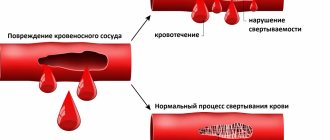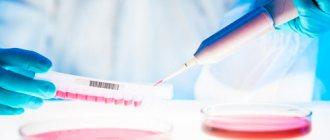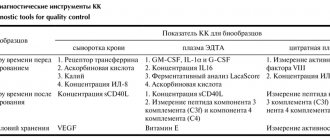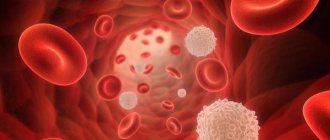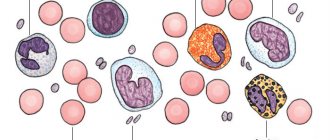Red blood cells - erythrocytes - are the largest population among the formed elements of blood. They contain the protein hemoglobin and have a specific shape in the form of a biconcave disc. Their important role is to transport oxygen to the cells of all organs and tissues and remove metabolic products in the form of carbon dioxide through the lungs into the atmosphere. Also on their surface, these cells carry some enzymes and amino acids, thereby performing a transport function. Their role in maintaining the acid-base balance in the body is also important. Of course, a decrease in the number of red blood cells below normal will affect the body due to tissue hypoxia, with the ensuing consequences.
Causes
The condition when red blood cells are low is called erythropenia. It underlies the disease - anemia. What are the causes of anemia?
Acute or chronic blood loss
Bleeding may be profuse as a result of trauma with damage to large vessels, damage to the liver or spleen. Bleeding stomach ulcers and hemorrhoids lead to anemia. With massive blood loss, hemorrhagic shock develops with a sharp decrease in pressure and subsequent development of multiple organ failure. Anemia that occurs due to blood loss is called posthemorrhagic.
In hereditary blood diseases, various modified forms of red blood cells occur
Insufficient production of red blood cells
The causes of this anemia are a deficiency of factors necessary for the formation of blood cells (iron, folic acid, vitamin B12). Deficiency can occur due to insufficient dietary intake or impaired absorption, for example, due to diseases of the stomach and intestines.
Hereditary blood diseases
There are groups of genetically determined diseases in which the red cells have defects and are destroyed ahead of schedule.
Enhanced Destruction
Normally, red blood cells function for about 120 days, after which they disintegrate in the spleen. The destruction of red blood cells prematurely is the cause of anemia.
Infection
In severe infectious diseases, the number of red blood cells decreases both as a result of the action of toxins on the bone marrow and as a result of increased destruction of red cells in the blood. Also, do not forget about parasitic diseases such as malaria.
Oncology
A reduced content of red blood cells in the blood can be caused by an oncological process that develops in the bone marrow directly, or as a result of metastasis of tumors from other organs.
Autoimmune diseases
Most often, low red blood cells can be detected in systemic connective tissue diseases, when the body produces antibodies, including to red cells.
Taking certain medications
For example, the fairly common drug phenobarbital, which is an integral part of a cardiac and sedative such as Corvalol, can lead to erythropenia if used frequently. In addition, chemotherapy drugs have an adverse effect on hematopoiesis in general, including red blood cells.
Etiology
A decrease in the number of red blood cells in the blood is spoken of in cases where their concentration differs significantly from the norm, which, in turn, depends on the gender and age of the person.
| Age category | Normal (10^12 cells per liter of blood) |
| Newborns | 3.6-6.6 |
| 1 month | 3-5.4 |
| 2-3 months | 2.7-4.9 |
| 5 months-2 years | 3.4-5.2 |
| From 3 to 6 years | 3.9-5.3 |
| From 7 to 12 years | 4-5.2 |
| Boys | 4.5-5.3 |
| Girls | 4.1-5.1 |
| Men | 3.9-5.5 |
| Women | 3.5-4.7 |
It should be noted that the above indicators may differ slightly depending on the laboratory equipment.
The main reasons leading to low red blood cells:
- any type of anemia;
- spread of metastases of malignant neoplasms of any location;
- blood hemolysis;
- prostate adenoma in men;
- leukemia;
- glomerulonephritis;
- infectious diseases such as whooping cough or diphtheria;
- diseases associated with the endocrine system;
- hemoglobinopathy;
- formation of stones in the kidneys;
- myeloma;
- hereditary blood pathologies, in particular ovalocytosis or microspherocytosis;
- cirrhosis of the liver;
- ruptures of internal organs, for example, the spleen;
- parasitic infestations;
- AIDS;
- Marchiafava-Micheli disease;
- massive blood loss;
- uterine, intestinal or hemorrhoidal bleeding;
- autoimmune pathologies.
The content of red blood cells can decrease not only against the background of one of the above ailments, but is also associated with the following factors:
- insufficient intake of iron and vitamins from food;
- long-term use of antibiotics for medicinal purposes;
- long-term addiction to drinking alcohol;
- the course of menstruation in women;
- refusal to eat;
- previous surgical intervention;
Also, a decrease in the level of red blood cells is observed during pregnancy or genetic predisposition.
About red blood cells
Features in pregnant women and children
Mild erythropenia may occur during pregnancy. Moreover, a slight decrease in red blood cells will be physiological, since pregnant women experience some fluid retention in the vascular bed. Thus, the blood seems to be diluted. If hemoglobin and red blood cells are low during pregnancy, iron supplements and additional examination, if necessary, are prescribed.
In pregnant women, a decrease in red blood cells to 3 million per μL is acceptable
In a child, a decrease in red blood cells should always be alarming. Children may not always admit to being injured, and there is a possibility of missing hidden bleeding. Also, a reduced level of red cells in a child may indicate the presence of a hereditary blood disease.
Newborns may have low red blood cell counts as a result of hemolysis, called hemolytic disease of the newborn. The reason for this is the mother’s antibodies to the baby’s red blood cells, transmitted through the placenta, and later through milk during breastfeeding.
What are the functions of cells?
These are blood cells that carry oxygen throughout the body. The process is as follows. Starting from the lungs, cells capture oxygen and continue to distribute it to all organs and tissues.
When the supply of capture ceases, the bodies return back for oxygen and at the same time capture carbon dioxide, simultaneously removing it from the body. That is why it is important to know the level of cells in the body, and also to monitor so that the number does not decrease.
Therefore, when getting an answer to the question of what red blood cells are responsible for in the blood, we can safely talk about high-quality oxygen pumping.
How does anemia manifest?
Symptoms of anemia are varied and depend on the severity of anemia and concomitant diseases.
In chronic anemia, when the decrease in red blood cells and hemoglobin occurs slowly, hemodynamics do not suffer. There is a gradual adaptation to the decrease in red blood cells. Concerned about weakness, increased fatigue, dizziness and headache. With a further decrease in red blood cells, fainting is possible.
Patients may have pale skin and mucous membranes. There may be a icteric tint due to hemolysis. Enlarged spleen – with hereditary pathology.
Neonatal jaundice due to hemolysis
Clinical symptoms of acutely developed bleeding will be characterized by severe weakness and possible loss of consciousness. Characterized by low blood pressure, cold and moist skin, and a rapid, thread-like pulse.
Anemia is the cause of low RBC
The most common cause of erythropenia is anemia of various origins:
- iron deficiency;
- B12 is deficient;
- hemolytic;
- hypoplastic.
The condition of anemia can be caused by hereditary factors or acquired during life. With B12 deficiency anemia, red blood cells decrease to 1* 10-12/l.
And if in the blood of an adult the red blood cells are reduced to the specified value or are less than 1* 10-12/l, then this indicates a severe form of anemia and means that it is necessary to immediately eliminate the cause that caused this condition in the patient.
Signs of increased erythropenia, increasing the risk of severe anemia, are the appearance of:
- Blood test after chemotherapy: normal, interpretation, general blood test
- shortness of breath, feeling of lack of air with little physical exertion;
- floaters before eyes;
- coldness, pallor of the skin, with massive destruction of red blood cells, yellowing of the skin is possible;
- yellowing of the eye sclera;
- dizziness;
- headache;
- weaknesses;
- low blood pressure;
- weak, rapid pulse;
- heartache.
Diagnosis and treatment
Treatment of anemia begins with a thorough diagnostic search for the root cause. Additional blood tests and instrumental research methods are prescribed, including fibrogastroscopy, colonoscopy, and ultrasound examination of organs located in the abdominal cavity and pelvis. For women, a gynecologist examination is required for prolonged and heavy menstruation.
Treatment depends on the cause. Iron supplements and vitamins B12, B9 are prescribed. If erythropoiesis is impaired in the bone marrow, drugs that stimulate the formation of red blood cells are indicated. In case of acute blood loss - surgical treatment and donor blood transfusion.
Diagnosis of anemia is based on a combination of clinical symptoms and examination data. The effectiveness of treatment depends on a correct diagnosis. Acute blood loss can end extremely sadly. Therefore, treatment is carried out under the supervision of a doctor of the appropriate profile.
Red blood cells and their role in the body
Red blood cells are called erythrocytes. They contain hemoglobin, which is a specific protein shaped like a biconvex disk.
These cells are primarily produced in the bone marrow. They perform very important functions in the body:
- transfer of oxygen to body tissues;
- removal of carbon dioxide;
- ensuring alkaline-acid balance.
With any deviation from the norm, a person feels unwell as a result of hypoxia. This condition can be caused by a number of serious and dangerous diseases.
Treatment
Pre-hospital assistance
The wound should be covered with a pressure bandage; in case of arterial bleeding, a tourniquet should be applied to the thigh or shoulder. Fractures are fixed using a splint or improvised objects (planks, thick cardboard). A patient with non-traumatic bleeding is provided with complete rest. When bleeding through the mouth, the patient is placed in a position that prevents aspiration. The discharge of blood from the mouth or anus, the occurrence of melena, and vomiting of coffee grounds is a reason to immediately call an emergency medical team.
Conservative therapy
The tactics of conservative treatment are determined by the cause of erythropenia and the existing symptoms. Victims with fractures require immobilization using a plaster cast or skeletal traction. In case of gastric bleeding, an ice pack is placed on the stomach area; in case of pulmonary bleeding, tracheal aspiration is performed. Asphyxia is an indication for immediate intubation, blood removal, and mechanical ventilation.
To correct hypovolemia in erythropenia caused by significant blood loss, infusions of rheopolyglucin, dextran, native plasma or gelatin solution are performed. Posthemorrhagic anemia is eliminated by transfusion of red blood cells. The volume of medical care is determined by the severity of erythropenia, the general condition of the patient, and may include resuscitation measures, monitoring of diuresis and vital signs.
Patients with erythropenia due to vitamin deficiency are prescribed a special diet and vitamin preparations. The underlying pathology that caused the vitamin deficiency is treated. Iron deficiency anemia due to bleeding is considered an indication for the use of iron supplements. In case of hemolytic anemia, red blood cell transfusion is supplemented with glucocorticoids and iron-binding agents.
Treatment of erythropenia against the background of hemoblastosis involves the organization of aseptic conditions, mono- or polychemotherapy, blood transfusion therapy, irradiation of the spleen and lymph nodes. For malignant tumors of various locations, chemotherapy and radiation therapy are prescribed.
Surgery
Taking into account the causes of erythropenia, the following operations are performed:
- Traumatic bleeding
: PSO of wounds and open fractures, thoracotomy or laparotomy with elimination of the source of blood loss. - Gastrointestinal bleeding
: ligation or sclerosis of esophageal veins, endoscopic arrest of gastric or intestinal bleeding by puncture and electrocoagulation, suturing of ulcers, gastric resection, colon resection. - Pulmonary hemorrhage
: endovascular embolization of bronchial arteries, extrapleural filling, thoracoplasty, pulmonary artery ligation, pulmonary resection, pneumonectomy. - Oncological pathologies
: bone marrow transplantation for leukemia, surgical removal of tumors of various locations with part of the affected organ or the entire organ.
Features of the analysis
Today, the mcv test is included in the general blood test or can be performed separately from other indicators. To donate blood, the patient must come to the treatment room, where a laboratory technician or nurse will take blood samples from a finger or vein. Blood sampling is carried out in accordance with all sanitary and epidemiological regulations (SanPiN).
The patient is required to comply with the following rules:
- You need to donate blood on an empty stomach (5-12 hours after your last meal);
- at the time of donation, the woman should not be menstruating;
- feeling normal. It is prohibited to take blood samples if the patient is not feeling well, is in a coma or is in cardiac shock.
3.Platelets
Thrombocytopenia
occurs as a consequence of bone marrow diseases or due to too intense destruction of platelets in the spleen. A lack of platelets causes bleeding of the mucous membranes, nosebleeds, subcutaneous hemorrhages, and internal bleeding (which is very dangerous). Some diseases associated with low platelet counts are hereditary.
Thrombocytosis
– excessive number of platelets in the blood. There are primary thrombocytosis (excessive production of platelets by the bone marrow) and secondary (reactive increase in platelet content due to infections, injuries, somatic and infectious diseases).
About our clinic Chistye Prudy metro station Medintercom page!
MCV is higher than normal
If the results are above normal, this indicates the development of macrocytic anemia. It can be directly related to diseases such as:
- drug intoxication;
- food poisoning;
- problems with the thyroid gland;
- lack of iodine or iron in the body;
- liver dysfunction;
- oncological process of red bone marrow;
- long-term alcoholism;
- disruption of the pancreas.
An increase in mcv can be caused by:
- long-term use of birth control pills that affect hormonal levels;
- addiction to cigarettes and tobacco products;
- prolonged contact with toxic substances (work in hazardous industries);
- taking medications that increase the level of mcv in the blood.
If left untreated, macrocytic anemia can lead to frequent fainting, poor health, and low hemoglobin levels in the blood. Particularly at risk are:
- people who eat poorly, lead a sedentary lifestyle and ignore exercise;
- patients with chronic liver failure;
- people with a genetic predisposition to the disease;
- men over fifty-five years of age who abuse alcohol.
Experts identify some signs by which one can understand that a person’s red blood cell volume is too high:
- unhealthy pale lips;
- abdominal pain for no particular reason, which appears very often;
- the presence of tachycardia (heartbeat too fast), even when the person is at rest;
- skin with a yellowish tint.
If you notice similar symptoms or detect an increased level of mcv in the blood, you must immediately consult a general practitioner for appropriate treatment.
4. Blood plasma
Blood plasma diseases are no less serious than a lack or excess of blood cells. Some of them develop so rapidly that it can be difficult to save the patient. Blood plasma is disrupted in the following diseases:
Sepsis
– infection of the blood itself, designed to fight infections in organs and tissues. Sepsis is very dangerous because the infection spreads through the bloodstream to the entire body at once.
Hemophilia
- a hereditary disease that affects only men. The absence of certain proteins in the blood plasma makes the blood almost unable to clot. With hemophilia, the slightest bleeding results in large blood loss, which is difficult to stop.
von Willebrand disease
– a protein necessary for blood clotting is produced and present in the plasma, but it does not perform its functions. This disease is also dangerous due to bleeding.
Multiple myeloma.
A malignant change in blood plasma cells, as a result of which various organs are affected and important functions are disrupted.
